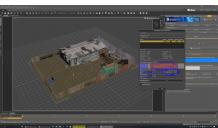Message to ALL content creators
 LITTLEFisky
Posts: 25
LITTLEFisky
Posts: 25
Please stop(!) putting insane resolution textures and applying insane meshes to your product! Not all of us have latest NVIDIA GPU with ***ton of VRAM


Rendertarget.jpg
2560 x 1500 - 506K


Comments
While other people have criticized that product for having high overhead, better to have "insane" textures (i.e. 4K, which is standard) and "insane" meshes (270 megabytes isn't a lot) than be stuck with sparse, bare products, a criticism I have of some of their other sets.
I'd rather downgrade from higher quality than try to upgrade from lower quality.
If it's really an issue, just use Scene Optimizer to shrink the texture maps down.
While I agree that some PAs go overboard with the detail and texturing with substance painter definitely doesn't help, you have to keep in mind that many users prefer this kind of detail and it's easier to tone it down than to add it. Also you are using a 3rd party renderer since will handle things differently than what iray and what most PAs are using.
You might want to invest in scene optimizer https://www.daz3d.com/scene-optimizer
it will definately help with the textures.
BTW what scene is that, I don't recognize it and would love to check it out.
If it's just large textures, they can be scaled down easily with for example Irfanview that does batch conversions, but often the UV mapping has been done in-efficiently, leaving 40-50% of the area unused, the worst I have seen so far has been a case where less than 5% of the area was actually used and in those cases scaling down doesn't help.
One easy thing to spot is miscellaneous maps that are just one color (usually black) and often the same resolution and color depth as the rest of the textures - These I usually take down to something like 128x128 pixels.
Memory usage of whatever textures can be calculated with Width (px) x Height (px) x color depth (bits) / 8 (bits) / 1024^2 = MegaBytes, the size of the texture file on disk doesn't matter as all the graphic files must be uncompressed when they are opened in whatever program.
@FSMCDesigns
FG Rundown Mobile
Thanks, will have to pick that up. Looking at it, it's a very busy scene, so no wonder it might be more taxing on a system than other scenes. To the OP, the more you have in a scene, the more it taxes your system.
I'm just glad they're getting away from those blank white walls that plagued their earlier products. Though if I did have a critique of this one, I'd say they should probably make complex scenes like this Polish-style, where it's broken down into components that can be loaded individually, rather than just an all-in-one preload.
They're pretty notorious 'round these parts for poorly optimized scenes, so it makes sense that they're the focus of this thread.
Most people prefer quality. They want the textures to look real. Real sells. It's very easy to reduce the size of the textures but keep in mind that it will become pixelated and will throw the textures off and you'll get poor quality on closer renders. You can also take out portions of the environment you don't want in the scene with a minor amount of knowhow if you don't want the full scene in the viewport. Granted, the environment should be modular when it's that big.
No problem if the UV mapping has been done 'sensibly", but often 40-50% of the texture area is not used on the model at all, which results in unnecessary memory usage.
The attached sample is the worst I have found, the insignificant surface had 5 textures/maps at 8192x8192 attached to it, which reserved almost a gigabyte of memory when 20MB's would have been enough for exactly the same level of detail.
That is true, but with medium shots I rarely if ever notice decreased quality even when downscaling by 4x (which reduces the memory usage to 1/16th)--and especially when coupled with depth of field. If a camera is close enough to notice reduced quality, most other props won't be visible and can therefore be removed anyway. The Scene Optimizer product also lets a user reduce textures on an object-by-object basis, so they could reduce the size of everything expect the focal prop.
Was that the only item using the map or was it used by other items, looking to different parts of ther map?
It was the only surface using those textures/maps, the rest of the area was filled with the garbage that Substance Painter does (as I'm told).
Since I figured what was the problem with that model, I have checked other 'heavy' models as well, and quite often the problem is in fact the same - Wasting space on the textures and maps.
^Was that the case for all the corresponding maps? E.g. if the diffuse map is mostly a solid colour for other objects/parts on the map but those others need detailing on the metal/roughness maps, you'd see wasted space on the diffuse map but not on the others. Separating the objects into their own maps would be more efficient if it were the only object in the scene, but the full scene would otherwise need more maps.
So if objects A, B and C share the same metal, roughness and normal maps, but object A is the only one with info in the diffuse map, looking at the diffuse map would show as wastage.
If that's the only object in the set with that set of maps ... then yeah, that'd be an odd decision.
I have often seen metallicity maps that are pure black (Irfanview reports there is just one color) and the size of the map is the same as all the other maps (8192x8192x24bit = 192MB's per that one file).
It may be that the UV map in itself has included UV clouds for other surfaces as well, but when making the textures/maps, the texturing program has divided them into separate files, increasing the memory usage into redicilous numbers.
If Substance Painter would not fill the unused areas of the texturefile/maps with garbage, one could combine the textures of several surfaces, but as it is, it is quite difficult to see the boundaries of the used area and when talking about 1000+ textures/maps, it was just too much work to fix everything and create new UV mapping for the surfaces.
Other idiotic desicions I have seen, are textures/maps for something like nail heads... You have 10000 nail heads and each and every one of them has been given it's own UV cloud, which are spread out to 8192x8192 textures/maps, again reserving close to 1GB for surfaces that have no real significance.
Substance Painter has different export options - the fill with padding is one option. A better one is pad to X-pixels (e.g. 32 pixels for a 4096x4096 is plenty) then leave the rest transparent so maps can be combined (it's what I do).
Nail heads ... gotta agree there. While some variety is good, having each with negligible texture space doesn't do any good. I suspect that's from making each nail independent then unwrapping the whole lot (rather than making a few, unwrapping those, then duplicating and mixing them up so there's no obvious repetition. In this case, you'd be better off just removing the maps and using solid textures (unless there's a super closeup of said nail, but even then, each nail would only have about 80x80 pixels anyway).
A question about the mobile home...does it have more than one room?